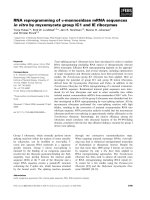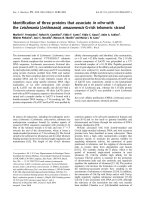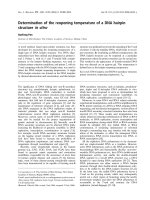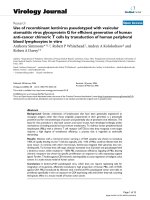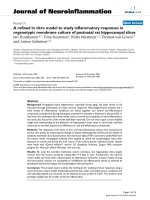Pathobiological studies of zoonotic blastocystis subtypes using in vitro model systems
Bạn đang xem bản rút gọn của tài liệu. Xem và tải ngay bản đầy đủ của tài liệu tại đây (6.56 MB, 275 trang )
PATHOBIOLOGICAL STUDIES OF ZOONOTIC !
BLASTOCYSTIS SUBTYPES USING IN VITRO
MODEL SYSTEMS
HARIS MIRZA
(Bachelor of Medicine, Bachelor of Surgery)
A THESIS SUBMITTED FOR THE DEGREE OF
DOCTOR OF PHILOSOPHY
DEPARTMENT OF MICROBIOLOGY
NATIONAL UNIVERSITY OF SINGAPORE
2011
“The universe is full of magical things, patiently waiting
for our wits to grow sharper.” Eden Phillpotts
DEDICATED WITH LOVE TO MY PARENTS &
FAMILY
!
i
ACKNOWLEDGEMENTS
This work would not have been possible without the exceptional support of many people
who selflessly provided me with their valuable time and help. I extend my deepest
gratitude to my supervisor Dr Kevin Tan for giving me the opportunity to work in his lab.
I highly appreciate his extraordinary guidance, patience and understanding that helped me
through the difficult periods of my candidature. His humor, friendship and
encouragement made my stay a fulfilling and enjoyable journey. The countless hours I
spent with him discussing scientific issues will remain a constant source of inspiration for
the rest of my life.
I would also like to thank Dr Jacqui Upcroft and Dr Linda Dunn for their guidance and
help. I also appreciate the valuable suggestions of A/Prof. Walter Hunziker, Prof. Vincent
Chow, A/Prof Ho Bow and Prof. Lim Chwee Teck.
I would also like to thank Ms Ng Geok Choo and Mr Ramachandran for their support
throughout the course of this project. Their assistance in lab matters and their patience is
highly appreciated. I would like to thank Mdm Siti Masnor for administrative assistance.
I also thank all the lecturers and staff of the Department of Microbiology for making this
a truly memorable journey.
I would like to thank National University of Singapore for granting me the scholarship to
pursue this project.
I sincerely thank Dr Manoj Kumar Puthia for his extraordinary friendship and guidance. I
also thank Dr Bin Hui, Dr Tao Fei and Dr Fahad Kidwai for their support and advise. I
ii
am also grateful for the support of Joshua Teo and Wu Zhaona and rest of the lab mates
from Dr Tan’s lab (Alvin, Jun Hong, Han Bin, Yinjing, Chu ling, Vivien, and Elizebeth).
Thank you very much for your friendship and for making the lab such a pleasant and
wonderful place to work in.
Lastly, I extend my deepest gratitude to my parents, my siblings and my wife
Khaula for their unconditional love and support.
Haris Mirza
2011
iii
CONTENTS
ACKNOWLEDGEMENTS
i
TABLE OF CONTENTS
iii
LIST OF FIGURES
ix
LIST OF TABLES
xii
LIST OF ABBREVIATIONS
xii
SUMMARY
xviii
LIST OF PUBLICATIONS
xx
CHAPTER 1:
INTRODUCTION
1-37
1.1
Introduction
1.2
Classification
1.3
Genetic diversity
1.4
Cell biology
1.5
Life cycle
1.6
Clinical presentation
1.7
Laboratory diagnosis
1.4
Blastocystis and irritable bowel syndrome
1.5
Opportunism
1.6
Treatment
1.7
Pathogenesis
1.8
Objectives of the present study
iv
CHAPTER 2:
INTER- AND INTRA-SUBTYPE VARIATION IN
BLASTOCYSTIS BASIC BIOLOGY, CYSTEINE
PROTEASE ACTIVITY AND ANTIBIOTIC
SUSCEPTIBILITY
38-85
2.1
Introduction
2.2
Materials and methods
2.2.1
Parasite culture
2.2.2
Culture on a 96-well platform for HTS
2.2.3
Preparation of lysate
2.2.4
Azocasein assay for cysteine protease activity
2.2.5
Flow-cytometric cell count and cell size analysis
2.2.6
Redox assays
2.2.7
Preparation of reference chemotherapeutic agents
2.2.8
Confocal microscopy
2.2.9
Statistical evaluation and validation
2.3
Results
2.3.1
Time-dependent variation in parasite protease
activity
2.3.2
Intra- and inter subtype variation in peak protease
activity
2.3.3
Time-dependent variation in parasite culture
morphology
2.3.4
Parasite generation times
2.3.5
Association between protease activity and cell
size
2.3.6
Blastocystis exhibits cell density-dependent
fluorimetric and colorimetric reactions with
Resazurin and XTT
2.3.7
200-µl/well volumes was required for optimal
metabolic activity of the parasite
v
2.3.8
Exponential growth of Blastocystis in
microcultures
2.3.9
Suitability of Resazurin and XTT for HTS of
Blastocystis drug
2.3.10
Blastocystis exhibits subtype-dependent variation
in susceptibility and resistance to Mz
2.3.11
An Mz
s
isolate of Blastocystis exhibits typical
morphological features of cell death after
exposure to Mz, as opposed to an Mz
r
isolate
2.3.12
Mz
r
isolates of Blastocystis exhibit cross-
resistance with a 1-position-substituted 5-NI
2.3.13
Blastocystis exhibits subtype-dependent
variations in susceptibility to NTZ, MQ, and QC
2.3.14
No subtype-dependent variations in FUR and QN
susceptibility
2.3.15
Higher susceptibility of Blastocystis spp. to a
TMP/SMZ ratio of 1:2 than to one of 1:5
2.3.16
Nonsusceptibility of Blastocystis to broad-
spectrum antibiotics
2.3.17
Cysteine protease inhibition causes parasite death
2.4
Discussion
CHAPTER 3
VARIATIONS IN NITRIC OXIDE
SUSCEPTIBILITY AND POTENTIAL FOR
EPITHELIAL INOS INHIBITION BETWEEN A ST-
4 AND A ST-7 ISOLATE OF BLASTOCYSTIS
86-110
3.1
Introduction
3.2
Materials and methods
3.2.1
Culture of Caco-2 colonic epithelial cell line
3.2.2
Parasite culture
vi
3.2.3
Parasite viability assay
3.2.4
Confocal microscopy (annexin-FITC/PI staining)
3.2.5
Determination of nitrite/nitrate in culture
supernatants
3.2.6
Real-time PCR
3.2.7
Arginase assay
3.2.8
Statistical analysis
3.3
Results
3.3.1
Variation between ST-4 (WR-1) and ST-7 (B)
susceptibility to nitrosative stress
3.3.2
Apical infection of intestinal epithelial cells by
ST-7 (B) inhibits apical epithelial nitric oxide
release.
3.3.3
Inducible nitric oxide synthase down regulation
3.3.4
Variation in arginase activity between ST-7 (B)
and ST-4 (WR-1) isolates
3.4
Discussion
CHAPTER 4:
BLASTOCYSTIS CYSTEINE PROTEASES INDUCE
INTESTINAL EPITHELIAL BARRIER
DYSFUCTION IN A STRAIN-DEPENDENT
MANNER
111-136
4.1
Introduction
4.2
Material and methods
4.2.1
Culture of Caco-2 colonic epithelial cell line
4.2.2
Parasite culture and lysate
vii
4.2.3
Epithelial resistance
4.2.4
Epithelial permeability
4.2.5
Immunohistochemistry and confocal microscopy
4.2.6
Statistical analysis
4.3
Results
4.3.1
Strain-to-strain variation in Blastocystis induced
drop in Caco-2 TER
4.3.2
Blastocystis ST-7 (B) induces an increase in
Caco-2 epithelial permeability to FITC
conjugated Dextran
4.3.3
Blastocystis ST-7 (B) cysteine proteases induce
ZO-1 rearrangement in Caco-2
4.3.4
Inhibition of Blastocystis ST-7 (B) cysteine
proteases prevented Caco-2 epithelial barrier
dysfunction
4.4
Discussion
CHAPTER 5:
SIMVASTATIN PREVENTS RHO KINASE-
MEDIATED EPITHELIAL BARRIER
DYSFUNCTION BY METRONIDAZOLE-
RESISTANT BLASTOCYSTIS
137-159
5.1
Introduction
5.2
Materials and methods
5.2.1
Parasite culture and lysates
5.2.2
Caco-2 cultures
5.2.3
Immunohistochemistry
5.2.4
Western blot
viii
5.2.5
Statistical analysis
5.3
Results
5.3.1
Blastocystis ST-7 (B) induces epithelial barrier
dysfunction in a Rho Kinase-dependent manner
5.3.2
Blastocystis ST-7 (B) induced ZO-1 and F-actin
reorganization is prevented by epithelial Rho
kinase inhibition
5.3.3
Blastoycstis induces Rho kinase-mediated
phosphorylation of Myosin Light Chain at ser-19
position
5.3.4
HMG CoA-reductase inhibition in Caco-2
prevents Blastocystis-induced epithelial barrier
dysfunction
5.3.5
Simvastatin is moderately cytotoxic to
metronidazole-resistant ST-7 (B)
5.4
Discussion
CHAPTER 6:
GENERAL DISCUSSION AND CONCLUSIONS
160-169
6.1
Discussion
6.2
Conclusions
REFERENCES
170-206
APPENDICES
207
PUBLICATIONS
214
ix
LIST OF FIGURE
Fig. 1.1
Phase contrast micrographs representing four morphological
forms of Blastocystis
11
Fig. 1.2
Fluorescence, light, and merged micrographs illustrating the
localization of cysteine proteases localized in central vacuole
of Blastocystis
15
Fig. 1.3
Proposed pathway of metabolism in the mitochondria like
organelle MLO of Blastocystis
16
Fig. 1.4
Proposed life cycle for Blastocystis suggesting the existence
of zoonotic genotypes (subtypes 1 to 7) with various host
specificities
18
Fig. 1.5
Proposed model for Blastocystis pathogenesis at the cellular
level
32
Fig. 2.1
Peak protease activity of Blastocystis isolates E, B, WR-1 and
S-1 determined by azocasein assays
58
Fig. 2.2
Protease activity fluctuations of Blastocystis isolates E, B,
WR-1 and S-1 over time
59
Fig. 2.3
Variations in cell size distribution of Blastocystis isolates B,
E, WR-1 and S-1 over time by flow cytometry
60
Fig. 2.4
Correlation between the number of subtype-7 parasites and
relative fluorescence units (RFU) (A) and relative absorbance
units (RAU)
62
Fig. 2.5
Correlation of total volume per well and dye concentration
with relative fluorescence units and relative absorbance units
63
Fig. 2.6
Blastocystis subtype-7 exhibits a time-dependent increase in
redox activity
64
Fig. 2.7
Graph representing percent inhibition of Blastocystis subtype-
4 and 7 cultures by Mz using the resazurin assay
65
x
Fig. 2.8
Chemical structures of position 1 and position 2 5-
nitroimidazoles
66
Fig. 2.9
Confocal micrographs of Blastocystis stained with propidium
iodide (arrow) and annexin V-FITC
67
Fig. 3.1
Confocal micrographs illustrating cell-death features of
Blastocystis under nitrosative stress
100
Fig. 3.2
Graph representing NO production by Blastocystis-infected
Caco-2 intestinal epithelium
101
Fig. 3.3
Graph representing NO production by Caco-2 intestinal
epithelium
102
Fig. 3.4
Graph representing down regulation of epithelial iNOS
expression by Blastocystis ST-7 (B) infection
103
Fig. 3.5
Arginase activity of Blastocystis ST-4 (WR-1) and ST-7 (B)
104
Fig. 3.6
Illustration summarizing evasion of host NO response by
Blastocystis
105
Fig. 4.1
Experimental set-up of epithelial barrier function model for
Blastocystis-host interaction studies
123
Fig. 4.2
Illustration representing gate function of ZO-1 tight junction
protein at the epithelial barrier
124
Fig. 4.3
Dose-dependent effect of Blastocystis ST-4 and ST-7 isolates
on transepithelial resistant (TER) of Caco-2 cell monolayers
125
Fig. 4.4
Time-dependent drop in Caco-2 TER by Blastocystis ST-7
cysteine proteases
126
Fig. 4.5
Flux measurement with FITC-conjugated Dextran. Confluent
monolayers of Caco-
2 cells were coincubated for 24 h with
Blastocystis ST-4 and ST-7 isolates
127
Fig. 4.6
Role of Blastocystis cysteine proteases in ST-7 (B)-induced
increase in Caco-2 permeability
128
Fig. 4.7
Representative confocal micrographs of alterations in ZO-1
and F-actin organization in Caco-2 monolayers
129
xi
Fig. 4.8
Representative confocal micrographs illustrating ZO-1 tight
junction localization in Caco-2 monolayers
130
Fig. 4.9
Quantification of ZO-1 staining in Blatocystis infected Caco-
2 monolayers
131
Fig. 5.1
Simplified schematic of the molecular changes for RhoA
prenylation leading to RhoA/ROCK activation
146
Fig. 5.2
Graph illustrating prevention of Blastocystis ST-7 (B)-
induced drop in Caco-2 TER by epithelial ROCK and HMG-
CoA reductase inhibition
147
Fig. 5.3
Graph representing drop in Caco-2 TER, 12 h after treatment
with Blastoycstis ST-7 (B) lysate in the presence or absence
of inhibitors (ROCK or HMG CoA reductase inhibitors)
149
Fig. 5.4
Graph representing increase in Caco-2 permeability to FITC
conjugated Dextran, 24 h after treatment with Blastocystis
ST-
7 (B) lysate in the presence or absence of inhibitors
(ROCK or HMG CoA reductase inhibitors)
150
Fig. 5.5
Representative confocal micrographs illustrating prevention
of Blastocystis-induced ZO-
1 and actin rearrangement in
Caco-
2 monolayers by ROCK and HMG CoA reductase
inhibition
151
Fig. 5.6
Quantification of ZO-1 staining in Blatocystis-infected Caco-
2 monolayers
152
Fig. 5.7
Representative western blot illustrating phosphorylation of
myosin light chain (MLC) in Caco-2 epithelium
153
Fig. 5.8
ROCK and HMG CoA reductase inhibitors prevent
Blastocystis induced phosphorylation of MLC
154
Fig. 5.9
Dose dependent curve representing antiparasitic effect of
Simvastatin against Mz
r
Blastocystis
155
Fig. 5.10
Illustration representing possible mechanisms employed by
Blastocystis to induce intestinal epithelial barrier dysfunction
159
Fig. 7.1
Illustration representing possible pathogenic and immune
evasion mechanisms of virulent Blastocystis subtype-7
169
xii
LIST OF TABLES
Table 1.1
Treatment options and regimens for blastocystosis
27
Table 2.1
Generation times of isolates belonging to subtype-7 and
subtype-4 in comparison with characteristics of cell size and
peak protease activity
68
Table 2.2
Statistical evaluation of the quality of resazurin and XTT assays
69
Table 2.3
Optimized parameters for resazurin and XTT assays
70
Table 2.4
IC
50
values of Blastocystis susceptibility to Mz
71
Table 2.5
IC
50
values of Blastocystis for 5-NIs by resazurin assay
72
Table 2.6
IC-50 values of antiprotozoal agents effective against
Blastocystis isolates using the resazurin assay
73
Table 3.1
Table stating IC-50’s of anti-Blastocystis activity of NO donors
99
xiii
LIST OF ABBREVIATIONS
°C
Degree Celsius
μ
Mean
σ
Standard deviation
Μm
Micro meter
AIDS
Acquired immune deficiency syndrome
AMP
Ampicillin
ATP
Adenosine triphosphate
Bp
Base pair
CoA
Coenzyme A
CQ
Chloroquine
C
v
Coefficient of variance
Cyt-D
Cytochalasin D
DAN
3-diaminonaphthalene
DMEM
Dulbecco’s modified Eagle medium
DMSO
Dimethyl sulfoxide
DOZ
Doxycycline
DTT
Dithiothreitol
ELISA
Enzyme-linked immunosorbent assay
EM
Emetine
FAD
Flavin Adenine Dinucleotide
xiv
FECT
Formalin Ether Concentration Technique
FITC
Fluorescein isothiocyanate
FUR
Furazolidone
GM-CSF
Granulocyte macrophage colony
stimulating factor
GSNO
S-Nitrosoglutathione
GTP
Guanosine triphosphate
h
Hour
HIV
Human immunodeficiency virus
HMG CoA
3-hydroxy-3-methyl-glutaryl-CoA
HTS
High throughput screening
IA
Iodoacetamide
IBS
Irritable bowel syndrome
IFN
Interferon
IgA
Immunoglobulin A
IL
Interleukin
IMDM
Iscove’s modified Dulbecco’s medium
iNOS
Inducible nitric oxide synthase
Min
Minute
ml
Milliliter
MLC
Myosin light chain
MLCp
Phophorylated myosin light chain
MLO
Mitochondria like organelle
xv
mM
Millimolar
MQ
Mefloquine
MV
Multivacuolar
Mz
Metronidazole
Mz
r
Metronidazole-resistant
Mz
s
Metronidazole-susceptible
NADH
Nicotinamide adenine dinucleotide
NaOH
Sodium hydroxide
NF-κB
Nuclear factor kappa-light-chain-
enhancer of activated B cells
NI
Nitroimidazole
nM
Nanomolar
Nm
Nanometer
NO
Nitric oxide
NS
Not susceptible
NTZ
Nitazoxanide
OD
Optical density
Oz
Ornidazole
PAR-2
Proteinase activated receptor 2
PAR
Paromomycin
PBS
Phosphate buffered saline
PCR
Polymerase chain reaction
PFOR
Pyruvate:Ferredoxin oxidoreductase
xvi
PI
Propidium iodide
PNO
Pyruvate:ferredoxin
oxidoreductase/NADPH-cytochrome
P450 reductase
PYR
Pyrimethamine
QC
Quinacrine
RAU
Relative absorbance unit
RFU
Relative fluorescence unit
ROCK
Rho associated kinase
RT-PCR
Reverse transcription PCR
Rz
Ronidazole
SMZ
Sulfamethoxazole
SNAP
S-nitroso-N-acetyl-l,l-penicillamine
SNP
sodium nitroprusside
ssrRNA
Small subunit RNA
ST
Subtype
TER
Transepithelial resistance
TID
Ter un die/ three times a day
TMP
Trimethoprim
Tz
Tinidazole
V
Vacuole
XIVC
Xenic in vitro culture
xvii
XTT
2,3-bis-(2-methoxy-4-
nitro-5-sulfophenyl)-2H-tetrazolium-5-
carboxanilide
ZO-1
Zonula occludens-1
xviii
SUMMARY
Blastocystis is a ubiquitous enteric parasite found in the intestinal tract of humans and a
wide range of animals. Accumulating evidence over the last decade suggests association
of Blastocystis with gastrointestinal disorders. Despite new knowledge of Blastocystis
cell biology, genetic diversity, life cycle and epidemiology; several key questions
concerning its clinical relevance remain unanswered. Numerous clinical and
epidemiological studies either implicated or exonerate the parasite as a cause of intestinal
disease. Clinical and experimental studies have associated Blastocystis with intestinal
inflammation and it has been shown that Blastocystis has potential to modulate host
immune response. Blastocystis is also considered an opportunistic pathogen and high
prevalence is reported in immunocompromised HIV patients. However, nothing is known
about the parasitic virulence factors and early events following host-parasite interactions.
A large number of asymptomatic carriers and frequent reports of treatment failure also
cast doubts over pathogenic potential of Blastocystis. Subtype-dependent variations in
Blastocystis pathobiology have been proposed to be the primary reasons for these
controversies, but direct experimental evidence is lacking.
The aim of this study was to investigate the pathogenic potential of Blastocystis, by
studying the interactions of zoonotic Blastocystis isolates belonging to subtype-4 and
subtype-7 with human intestinal epithelial cell line Caco-2. This study reports that a
pathogenic strain of Blastocystis evades antiparasitic host nitric oxide response by
suppression of epithelial iNOS, making intestinal environment more conducive to its
colonization. Following immune evasion, Blastocystis cysteine proteases rearrange F-
xix
actin and tight junction distribution, decrease transepithelial resistance, and increases
epithelial permeability in Caco-2 monolayers. A strain-to-strain and not subtype-
dependent variation in Blastocystis virulence was observed. Only one of the four isolates
tested in this study suppressed Caco-2 iNOS and compromised epithelial barrier function.
In addition, it was demonstrated that effects of Blastocystis on transepithelial electrical
resistance and epithelial permeability were significantly abrogated by inhibition of
epithelial Rho kinase.
Additionally high-throughput drug susceptibility assays were developed for Blatocystis.
Antibiotic susceptibility studies on these assays suggested that pathogenic strain of the
parasite is resistant to metronidazole, the treatment of choice against Blastocystis
infections. A subtype-dependent variation in susceptibility to a range of antimicrobial
agents was also observed, suggesting that although subtyping of Blastocystis might not be
useful in identification of virulent strains, but it does help in predicting treatment
outcomes.
Lastly, epithelial barrier dysfunction induced by pathogenic and metronidazole-resistant
Blastocystis was significantly inhibited by inhibition of epithelial Rho kinase and HMG
CoA reductase by Fasudil and Simvastatin respectively. Both these agents are clinically
useful and could provide alternative or adjunctive treatment options against antibiotic
resistant Blastocystis infections. These findings will certainly help to understand
pathobiology of a poorly studied parasite whose public health importance is increasingly
recognized. Our findings also suggest novel treatment options against antibiotic resistant
and potentially virulent Blastocystis strains.
xx
PUBLICATIONS ARISING FROM THE THESIS
A.
International Refereed Journals
1.
Haris Mirza, Joshua DW Teo, Jacqui Upcroft & Kevin SW Tan. A
rapid, high-throughput viability assay for Blastoctystis spp. reveals
metronidazole resistance and extensive subtype-dependent variations in
drug susceptibilities (2011). Antimicrobial Agents and
Chemotherapy, 55:637-648
2.
Haris Mirza, Wu Zhaona, Fahad Kidwai, Kevin SW Tan. A
metronidazole-resistant isolate of Blastocystis spp. is susceptible to nitric
oxide and downregulates intestinal epithelial inducible nitric oxide
synthase by a novel parasite survival mechanism (2011). Infection and
Immunity, 79:5019-26
3.
Kevin SW Tan, Haris Mirza, Joshua DW Teo, Binhui Wu & Paul
A. MacAry. Current views on the clinical relevance of Blastocystis
spp. (2010). Current Infectious Disease Reports, 12:28-35
4.
Haris Mirza & Kevin SW Tan. Blastocystis exhibits inter- and
intra-subtype variation in cysteine protease activity (2009).
Parasitology Research, 104:355-361
B.
Manuscripts Under Preparation
xxi
1.
Haris Mirza, Wu Zhaona, Tao Fei, Joshua DW Teo, Kevin SW
Tan. Blastocystis cysteine proteases induce epithelial barrier
dysfunction and ZO-1 rearrangement in a strain-dependent manner.
2.
Haris Mirza, Wu Zhaona, Joshua DW Teo, Kevin SW Tan.
Simvastatin prevents ROCK/MLCp mediated epithelial barrier
dysfunction by metronidazole-resistant Blastocystis
C.
Conference Papers
1.
Kevin SW Tan, Haris Mirza, Joshua DW Teo, Ng Geok Choo.
Subtype-associated variations in Blastocystis pathology. 45
th
Annual
Japan-US Joint Conference on Parasitic Diseases, 10-12 January
2011, National Institute of Infectious Diseases, Tokyo, Japan.
2.
Haris Mirza, Joshua DW Teo & Kevin SW Tan. Manipulation of
host Rho/ROCK pathway by emerging protozoan pathogen
Blastocystis results in subtype-dependent compromise of intestinal
epithelial barrier function. 12th International Congress of Parasitology
(ICOPA), 15-20th August 2010, Melbourne, Australia.
xxii
3.
Haris Mirza, Joshua DW Teo, Jacqui Upcroft & Kevin SW Tan.
Identification of metronidazole resistance and evaluation of alternate
treatment options for Blastocystis infections using redox based in
vitro drug susceptibility assays. 12th International Congress of
Parasitology (ICOPA), 15-20th August 2010, Melbourne, Australia
4.
Haris Mirza, Joshua DW Teo, Jacqui Upcroft & Kevin SW Tan.
Blastocystis spp. exhibit metronidazole resistance and extensive
subtype-dependent variations in drug susceptibilities. 10th Nagasaki-
Singapore Symposium on Infectious Diseases, 15
th
-16
th
April 2010,
Singapore
5.
Haris Mirza, Joshua DW Teo & Kevin SW Tan. Role of Rho
associated kinase (ROCK) in Blastocystis induced increase in
intestinal epithelial permeability. The 3
rd
Mechanobiology Workshop,
3
rd
-5
th
November 2009, Singapore.
6.
Kevin SW Tan & Haris Mirza. Blastocystis-host interactions: new
insights on pathogenesis. 3
rd
Ditan International Conference on
Infectious diseases, July 30
th
-2
nd
August 2009, Beijing, China
7.
Haris Mirza & Kevin SW Tan. Comparison and optimization of high
throughput in vitro drug susceptibility microassays for the emerging
protozoan pathogen Blastocystis. 26
th
International Congress of
Chemotherapy and Infection, June 18
th
-21
st
2009, Toronto, Canada

